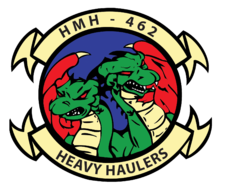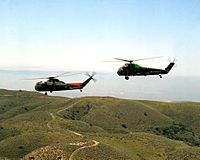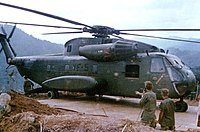| Marine Heavy Helicopter Squadron 462 | |
|---|---|
 HMH-462 Unit insignia | |
| Active |
|
| Country | United States |
| Allegiance | United States of America |
| Branch | United States Marine Corps |
| Type | Marine Heavy Helicopter Squadron |
| Role | Assault Support |
| Part of |
Marine Aircraft Group 16 3rd Marine Aircraft Wing |
| Garrison/HQ | Marine Corps Air Station Miramar |
| Nickname(s) |
"Heavy Haulers" "The Screw Crew" |
| Tail Code | YF |
| Engagements |
Vietnam War * Operation Eagle Pull * Operation Frequent Wind Operation Desert Storm Operation Iraqi Freedom * 2003 invasion of Iraq |
Marine Heavy Helicopter Squadron 462 (HMH-462) is a United States Marine Corps helicopter squadron consisting of CH-53E Super Stallion heavy transport helicopters. The squadron, known as the "Heavy Haulers", is based at Marine Corps Air Station Miramar, California and falls under the command of Marine Aircraft Group 16 (MAG-16) and the 3rd Marine Aircraft Wing (3rd MAW).
History[]
World War II[]

Squadrons logo during WWII when they were VMF-462
Marine Fighting Squadron 462 (VMF-462) was activated Marine Corps Air Station El Centro, California on April 15, 1944. On October 10, 1944 the squadron absorbed personnel and equipment from VMF-481 and they were redesignated a fighter pilot replacement training unit. Shortly thereafter they transferred to Marine Corps Air Station El Toro, California and remained there until the end of the war. The squadron was quickly deactivated after the war's end on September 10, 1945.[1]
1950s and early 1960s[]

A HMH-462 CH-37C with an UH-34D from HMM-363 near MCAS Tustin, 1964.
On November 1, 1957, 462 was reactivated at Marine Corps Air Facility Santa Ana, California as Marine Helicopter Transport Squadron (Medium) 462 HMR(M)-462. In March 1958 the squadron received the Sikorsky HR2S-1(CH-37 Mojave), known as the "Deuce." In July 1958 the squadron participated in NASA’s abort recovery tests of the Mercury space capsule in the Salton Sea. During July 1959 HMR(M)-462 worked with the United States Army in El Paso, Texas to conduct the initial aerial transport tests of the Hawk missile system. One year later, the squadron worked with Convair Astronautics Corporation in San Diego to help construct Atlas missile silos. Also during 1960, HMR(M)-462 joined with the Federal Aviation Administration, Sikorsky Aircraft, the U.S. Army, New York Airways and British technical representatives of the Decca Corporation to establish Instrument Flight Procedures for helicopters. During the mid-1960s the squadron changed their logo and began acceptance of the CH-53A "Stallion".
Vietnam War[]

CH-53 from HMH-462 atop a mountain side base in Vietnam, in 1968.
In August 1968, the "Heavy Haulers" deployed to the Republic of Vietnam for combat operations. Assigned to Marine Aircraft Group 36 at Phu Bai, the squadron was tasked with the tactical retrieval of downed aircraft and heavy equipment during Operation End Sweep. In March 1971, HMH-462 was transferred to Okinawa to provide support to Marine forces in Japan. In 1975 HMH-462, still stationed in Okinawa, was assigned to the 9th MAB and 31st Marine Expeditionary Unit. On 12 April 1975 the "Heavy Haulers" operating from USS Okinawa (LPH-3), participated in Operation Eagle Pull, the evacuation of Phnom Penh. Seventeen days later from 29–30 April, HMH-462 participated in Operation Frequent Wind, the evacuation of Saigon.[2] Shortly thereafter, the squadron was embarked upon the USS Hancock (CV-19) and sailed back towards Cambodia to participate in the rescue operation of the SS Mayaguez. The Mayaguez rescue was completed before the Hancock arrived on station and the Hancock returned to Subic Bay.
Post Vietnam and the 1990s[]
After nearly ten years of continuous overseas service, HMH-462 was relocated to Marine Corps Air Station Tustin, California and assigned to Marine Aircraft Group 16. They also participated in the Unit Deployment Program to MCAS Futenma, Okinawa, In December 1989, a squadron detachment was assigned to participate in coup contingency operations in the Republic of the Philippines as part of Marine Aircraft Group 90.
In August 1990, the "Heavy Haulers" were assigned to Marine Aircraft Group 70 and deployed to Jubail, Saudi Arabia as part transport, MEDEVAC, VIP, and FARP support to MAG-70/16 and I Marine Expeditionary Force operations.
In February 1991, the squadron relocated to Tanajib, Saudi Arabia, where it provided support for Operation Desert Storm. Following the conclusion of hostilities, the squadron returned to MCAS Tustin. During March 1991, the squadron received the 1990 Chief of Naval Operations Safety Award. In September, the squadron reached another milestone when it completed 15,000 class A mishap free flight hours. In 1992 it was also announced that HMH-462 had been selected for transition to the CH-53E Super Stallion. In June, the Heavy Haulers took possession of their first CH-53E Super Stallion and began the transition process.

A HMH-462 CH-53E in 2002.
In 1996, the squadron reached another milestone when it completed 28,000 class A mishap free flight hours. In May of the same year, after completing another unit deployment to Okinawa, Japan. The "Heavy Haulers" received the Heavy Helicopter Squadron of the Year Award from the Marine Corps Aviation Association for 1996.
In March 1997, HMH-462 surpassed 30,000 class A mishap free flight hours. After returning home in May 1998 from another unit deployment cycle. They became the first helicopter squadron in MAG-16 to make the transition from Tustin to MCAS Miramar, California. In December of the same year, HMH-462 surpassed yet another class A mishap free flight hour milestone of 35,000 hours and received the Heavy Helicopter Squadron of the Year award for 1998.
The Global War on Terror[]
HMH 462 served in Operation Iraqi Freedom from February 2003 to September 2003 and Operation Enduring Freedom from September 2004 to May 2005. They flew many missions supporting logistics and combat missions involving insertion and extraction of special forces groups. The squadron is currently preparing for another deployment in support of the Global War on Terror.[3]
See also[]
- United States Marine Corps Aviation
- Organization of the United States Marine Corps
- List of active United States Marine Corps aircraft squadrons
References[]
This article incorporates public domain material from websites or documents of the United States Marine Corps.
- Notes
- ↑ Sherrod History of Marine Corps Aviation in WWII, p.471.
- ↑ "Chapter 5: The Final Curtain, 1973 - 1975". history.navy.mil. 2000. http://www.history.navy.mil/seairland/chap5.htm. Retrieved 2007-07-24.
- ↑ ‘Heavy Haulers’ prepare for deployment
- Books
- Rottman, Gordon L. (2002). U.S. Marine Corps World War II Order of Battle - Ground and Air Units in the Pacific War, 1939 - 1945.’’. Greenwood Press. ISBN 0-313-31906-5.
- Sherrod, Robert (1952). History of Marine Corps Aviation in World War II. Washington, D.C.: Combat Forces Press.
- Web
| ||||||||||||||||||||||||||
| |||||||||||||||||||||||
The original article can be found at HMH-462 and the edit history here.

